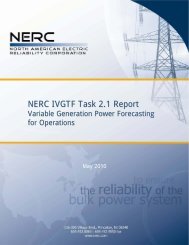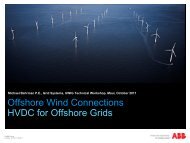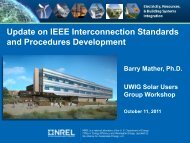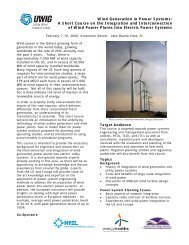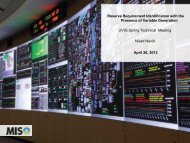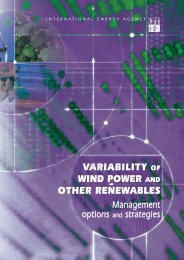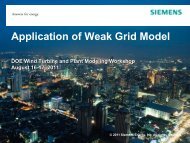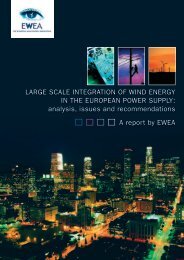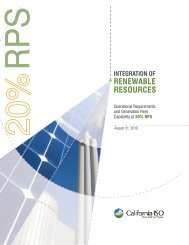Integrating Southwest Power Pool Wind to Southeast Electricity ...
Integrating Southwest Power Pool Wind to Southeast Electricity ...
Integrating Southwest Power Pool Wind to Southeast Electricity ...
You also want an ePaper? Increase the reach of your titles
YUMPU automatically turns print PDFs into web optimized ePapers that Google loves.
1<br />
INTRODUCTION AND BACKGROUND<br />
Project Overview<br />
<strong>Wind</strong> power development in the United States is outpacing previous estimates for many regions,<br />
particularly those with good wind resources. The pace of wind power deployment may soon<br />
outstrip regional capabilities <strong>to</strong> provide transmission and integration services <strong>to</strong> achieve the most<br />
economic power system operation. Conversely, regions such as the <strong>Southeast</strong>ern United States<br />
do not have good wind resources and will have difficulty meeting proposed federal Renewable<br />
Portfolio Standards with local supply. There is a growing need <strong>to</strong> explore innovative solutions<br />
for collaborating between regions <strong>to</strong> achieve the least cost solution for meeting such a renewable<br />
energy mandate.<br />
The DOE-funded project “<strong>Integrating</strong> <strong>Southwest</strong> <strong>Power</strong> <strong>Pool</strong> <strong>Wind</strong> Energy in<strong>to</strong> <strong>Southeast</strong><br />
<strong>Electricity</strong> Markets” aims <strong>to</strong> evaluate the benefits of coordination of scheduling and balancing<br />
for <strong>Southwest</strong> <strong>Power</strong> <strong>Pool</strong> (SPP) wind transfers <strong>to</strong> <strong>Southeast</strong>ern Electric Reliability Council<br />
(SERC) Balancing Authorities (BAs). The primary objective of this project is <strong>to</strong> analyze the<br />
benefits of different balancing approaches with increasing levels of inter-regional cooperation.<br />
Scenarios were defined, modeled and investigated <strong>to</strong> address production variability and<br />
uncertainty and the associated balancing of large quantities of wind power in SPP and delivery <strong>to</strong><br />
energy markets in the southern regions of the SERC.<br />
The primary analysis of the project is based on unit commitment (UC) and economic dispatch<br />
(ED) simulations of the SPP-SERC regions as modeled for the year 2022. The UC/ED models<br />
utilized for the project were developed through extensive consultation with the project utility<br />
partners, <strong>to</strong> ensure the various regions and operational practices are represented as accurately as<br />
possible realizing that all such future scenario models are quite uncertain. SPP, Entergy,<br />
Oglethorpe <strong>Power</strong> Company (OPC), Southern Company, and the Tennessee Valley Authority<br />
(TVA) actively participated in the project providing input data for the models and review of<br />
simulation results and conclusions. While other SERC utility systems are modeled, the listed<br />
SERC utilities were explicitly included as active participants in the project due <strong>to</strong> the size of their<br />
load and relative proximity <strong>to</strong> SPP for importing wind energy.<br />
The analysis aspects of the project comprised 4 primary tasks:<br />
1. Development of SCUC/SCED model of the SPP-SERC footprint for the year 2022 with<br />
only 7 GW of installed wind capacity in SPP for internal SPP consumption with no<br />
intended wind exports <strong>to</strong> SERC. This model is referred <strong>to</strong> as the “Non-RES” model as it<br />
does not reflect the need for the SPP or SERC BAs <strong>to</strong> meet a federal Renewable Energy<br />
Standard (RES).<br />
2. Analysis of hourly-resolution simulation results of the Non-RES model for the year 2022<br />
<strong>to</strong> provide project stakeholders with confidence in the model and analytical framework<br />
for a scenario that is similar <strong>to</strong> the existing system and more easily evaluated than the<br />
high-wind transfer scenarios that are analyzed subsequently.<br />
1-1




